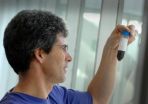(Press-News.org) A study into the effects of Sanfilippo Syndrome type B (MPS III B) has found that the barrier responsible for protecting the brain from the entry of harmful blood-borne substances is structurally and functionally damaged by the devastating disease. University of South Florida researchers identified damage in specific brain structures involved in the pathology of MPS III B, one of four Sanfilippo syndromes, all of which are inherited diseases of metabolism.
The study, using a mouse model of MPS III B, has been published online in the journal PLoS One. Before this study, little was known about the integrity of the blood-brain barrier in this disease. (www.plosone.com)
"These new findings about blood-brain barrier structural and functional impairment in MPS III B mice, even at early disease stage, may have implications for disease pathogenesis and should be considered in the development of treatments for MPS III B," said study lead author Svitlana Garbuzova-Davis, PhD, an assistant professor in the Department of Neurosurgery and Brain Repair at the University of South Florida.
Sanfilippo syndrome type B is caused by a deficiency in the Naglu gene, the gene responsible for producing an enzyme needed to degrade heparan sulfate. Naglu-deficient mice show progressive deterioration of movement, vision and hearing. Neurons in various parts of the brain – including the olfactory bulb, cortex, thalamus, amygdala, and other areas – are affected by the disease. Consequently, patients with MPS III B experience a variety of pathological brain changes.
"Among our findings was that endothelial cells and other cells comprising the blood-brain barrier are damaged, resulting in vascular leakage," said Dr. Garbuzova-Davis. "This compromise may lead to destruction of the fragile central nervous system equilibrium."
Dr. Garbuzova-Davis and her co-researchers also reported that the "insult to blood-brain barrier integrity" likely comes from accumulated storage products within the endothelial cells, which are primary cellular components of the BBB. The authors noted that it is possible that blood-brain barrier dysfunction occurred before, or concurrent with, the appearance of neuropathological changes in MPS III B.
"Interestingly, more capillary leakage was seen in some brain structures, such as the hippocampus, in early symptomatic mice than in late symptomatic mice," Dr. Garbuzova-Davis said. "We speculate that the regions of the brain differ in metabolic functional activity, especially in growing animals, and higher activity may require more substantial exchanges of nutrients and metabolic activity. If the blood-brain barrier is already weakened in these areas, more vascular leakage may occur."
The authors report that capillary endothelial cell dysfunction may accelerate neuropathological changes in MPS III B by potentially allowing harmful blood-borne soluble substances, including neurotoxins, to enter the central nervous system.
"Alternatively, damaged endothelial cells may alter specific mechanisms for transport of various solutes across the blood-brain barrier," said Paul Sanberg, PhD, DSc, executive director of USF Center of Excellence for Aging and Brain Repair and co-author of the paper. "In this scenario, neural cells might suffer the dual effects of reduced nutrition and increased metabolite levels, impairing central nervous system function."
The researchers concluded that determining the evolution of blood-brain barrier dysfunction in MPS III B is important for both understanding how the disease progresses and for developing therapies. One possibility for blood-brain barrier repair is replacement of affected endothelial cells with endothelial progenitor cells from bone marrow or umbilical cord blood. Because a microaneurysm was noted in the brain of a mouse modeling MPS III B, the authors also suggest that special attention be given to the possibility of cerebral hemorrhage in MPS III B patients caused by weakened integrity.
###
The study was funded by the Children's Medical Research Foundation. Other USF authors were Michael K. Louis, Edward M. Haller, Hiranya M. Derasari, and Ashley E. Rawls.
(http://www.plosone.org/article/info%3Adoi%2F10.1371%2Fjournal.pone.0016601;jsessionid=AECDC1A0B585E6DE9CE331B8F7E7D6BF.ambra02)
USF Health
USF Health is dedicated to creating a model of health care based on understanding the full spectrum of health. It includes the University of South Florida's colleges of Medicine, Nursing, Public Health and Pharmacy, the School of Biomedical Sciences and the School Physical of Therapy and Rehabilitation Sciences; and the USF Physician's Group. With more than $394.1 million in research grants and contracts in FY2009/2010, the University of South Florida is a high impact global research university.
University of South Florida researchers find blood-brain barrier damaged by disease
Sanfilippo syndrome compromises the barrier, leading to brain damage in mouse model
2011-03-09
ELSE PRESS RELEASES FROM THIS DATE:
Cancer in HIV-positive patients
2011-03-09
Most HIV-positive patients die of cancer. In the latest issue of Deutsches Ärzteblatt International (Dtsch Arztebl Int 2011; 108[8]: 117), Manfred Hensel's research group presents epidemiological data.
The authors surveyed all German hospital outpatient clinics and ambulatory care centers specializing in the treatment of HIV patients in the period from 2000 to 2007 and were thus able to analyze the largest collection of data on the incidence of cancer in HIV patients ever assembled in Germany. It first became clear in the early 1980s that HIV infection is associated ...
Boston researchers create 'SMArt' platform architecture, launch $5,000 health app competition
2011-03-09
Boston, Mass. – Through a grant from the Office of the National Coordinator for Health Information Technology (ONC), researchers at Children's Hospital Boston and Harvard Medical School have developed a first-of-its kind platform architecture to support a flexible health information technology (IT) environment and promote innovation. The SMArt (Substitutable Medical Applications, reusable technologies) platform and interface are being made publicly available today to kick off the start of a $5,000 competition challenging developers to create web applications that provide ...
Research finds open-source software is actually more secure for health care IT
2011-03-09
Globally the sale of health care information systems is a multibillion dollar industry. The vast costs, frequent failed systems, and inability of systems to talk to each other regularly attract media comment. However policy makers still shy away from a class of software, Open Source, that could address many of these problems, because of worries about the safety and security of Open Source systems. Now new research by the University of Warwick's Institute for Digital Healthcare, and the Centre for Health Informatics and Multiprofessional Education at UCL Medical School, ...
Identifying 'anonymous' email authors
2011-03-09
Montreal, March 8, 2011 – A team of researchers from Concordia University has developed an effective new technique to determine the authorship of anonymous emails. Tests showed their method has a high level of accuracy – and unlike many other methods of ascertaining authorship, it can provide presentable evidence in courts of law. Findings on the new technique are published in the journal Digital Investigation.
"In the past few years, we've seen an alarming increase in the number of cybercrimes involving anonymous emails," says study co-author Benjamin Fung, a professor ...
Spanish tourists criticize other Mediterranean countries' lack of hospitality
2011-03-09
People visiting Spain have a high opinion of the price-quality ratio of Spanish hotels. Spanish tourists, on the contrary, complain about the quality of hotels, cleanliness and hospitality in countries such as Italy, Greece and France. This is one of the conclusions of a study carried out by the University of Cádiz (UCA) on tourism in southern Mediterranean countries.
"The five aspects most-highly rated by tourists travelling in the countries of the European Mediterranean are the leisure-spectacle activities, organised routes-excursions, cultural activities, the weather ...
Aging with grace: In-home assessments lead to better care, lower health costs
2011-03-09
INDIANAPOLIS – The March 2011 issue of the journal Heath Affairs highlights an evidence-based model of geriatric care management developed, implemented and tested by researchers and clinicians from Indiana University, the Regenstrief Institute and Wishard Health Services.
Geriatric Resources for Assessment and Care of Elders (GRACE) optimizes the health and functional status of community dwelling lower income, older adults. GRACE is now in use by Wishard Health Services, the third-largest safety-net health organization in the United States; by HealthCare Partners Medical ...
Oops -- graphene oxide's solubility disappears in the wash
2011-03-09
Graphene Oxide has had a scrum of researchers fall upon it as it retains much of the properties of the highly valued super material pure Graphene, but it is much easier, and cheaper, to make in bulk quantities; easier to process; and its significant oxygen content appears to make it soluble in water. However new research led by University of Warwick Chemist Dr Jonathan P. Rourke and Physicist University of Warwick Physicist Dr Neil Wilson, has found that that last assumption is incorrect and unfortunately Graphene oxide's solubility literally comes out in the wash.
Drs ...
The cerebellum provides clues to the nature of human intelligence
2011-03-09
Milan, Italy, 8 March 2011 – Research suggests that intelligence in humans is controlled by the part of the brain known as the 'cortex', and most theories of age-related cognitive decline focus on cortical dysfunction. However, a new study of Scottish older adults, reported in the April 2011 issue of Elsevier's Cortex (http://www.sciencedirect.com/science/journal/00109452), suggests that grey matter volume in the 'cerebellum' at the back of the brain predicts cognitive ability, and keeping those cerebellar networks active may be the key to keeping cognitive decline at ...
MU chemist discovers shortcut for processing drugs
2011-03-09
COLUMBIA, Mo. – A prolific University of Missouri chemist has discovered a quicker and easier method for pharmaceutical companies to make certain drugs.
Jerry Atwood, Curator's Professor and Chair of the Department of Chemistry in the MU College of Arts and Science, has recently published a paper – his 663rd in a refereed journal – that states that highly pressurized carbon dioxide at room temperature could replace the time consuming and expensive methods currently used to manufacture certain pharmaceutical drugs.
In the article, "A New Strategy of Transforming Pharmaceutical ...
Study shows no-till's benefits for Pacific Northwest wheat growers
2011-03-09
This release is available in Spanish.
Wheat farmers in eastern Oregon and Washington who use no-till production systems can substantially stem soil erosion and enhance efforts to protect water quality, according to research by U.S. Department of Agriculture (USDA) scientists.
Agricultural Research Service (ARS) hydrologist John Williams led a study that compared runoff, soil erosion and crop yields in a conventional, intensively tilled winter wheat-fallow system and a no-till 4-year cropping rotation system. ARS is USDA's chief intramural scientific research agency, ...
LAST 30 PRESS RELEASES:
Making lighter work of calculating fluid and heat flow
Normalizing blood sugar can halve heart attack risk
Lowering blood sugar cuts heart attack risk in people with prediabetes
Study links genetic variants to risk of blinding eye disease in premature infants
Non-opioid ‘pain sponge’ therapy halts cartilage degeneration and relieves chronic pain
AI can pick up cultural values by mimicking how kids learn
China’s ecological redlines offer fast track to 30 x 30 global conservation goal
Invisible indoor threats: emerging household contaminants and their growing risks to human health
Adding antibody treatment to chemo boosts outcomes for children with rare cancer
Germline pathogenic variants among women without a history of breast cancer
Tanning beds triple melanoma risk, potentially causing broad DNA damage
Unique bond identified as key to viral infection speed
Indoor tanning makes youthful skin much older on a genetic level
Mouse model sheds new light on the causes and potential solutions to human GI problems linked to muscular dystrophy
The Journal of Nuclear Medicine ahead-of-print tip sheet: December 12, 2025
Smarter tools for peering into the microscopic world
Applications open for funding to conduct research in the Kinsey Institute archives
Global measure underestimates the severity of food insecurity
Child survivors of critical illness are missing out on timely follow up care
Risk-based vs annual breast cancer screening / the WISDOM randomized clinical trial
University of Toronto launches Electric Vehicle Innovation Ontario to accelerate advanced EV technologies and build Canada’s innovation advantage
Early relapse predicts poor outcomes in aggressive blood cancer
American College of Lifestyle Medicine applauds two CMS models aligned with lifestyle medicine practice and reimbursement
Clinical trial finds cannabis use not a barrier to quitting nicotine vaping
Supplemental nutrition assistance program policies and food insecurity
Switching immune cells to “night mode” could limit damage after a heart attack, study suggests
URI-based Global RIghts Project report spotlights continued troubling trends in worldwide inhumane treatment
Neutrophils are less aggressive at night, explaining why nighttime heart attacks cause less damage than daytime events
Menopausal hormone therapy may not pose breast cancer risk for women with BRCA mutations
Mobile health tool may improve quality of life for adolescent and young adult breast cancer survivors
[Press-News.org] University of South Florida researchers find blood-brain barrier damaged by diseaseSanfilippo syndrome compromises the barrier, leading to brain damage in mouse model



